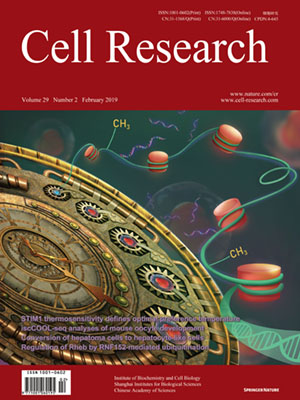
Volume 29, No 2, Feb 2019
ISSN: 1001-0602
EISSN: 1748-7838 2018
impact factor 17.848*
(Clarivate Analytics, 2019)
Volume 29 Issue 2, February 2019: 124-135
ORIGINAL ARTICLES
Conversion of hepatoma cells to hepatocyte-like cells by defined hepatocyte nuclear factors
Zhuo Cheng 1, Zhiying He 2, Yongchao Cai 2, Cheng Zhang 1, Gongbo Fu 1, Hengyu Li 1, Wen Sun 1, Changcheng Liu 2, Xiuliang Cui 1,Beifang Ning 3, Daimin Xiang 1, Tengfei Zhou 1, Xiaofeng Li 1, Weifen Xie 3, Hongyang Wang 1,4 and Jin Ding 1,4
1 International Cooperation Laboratory on Signal Transduction, Eastern Hepatobiliary Surgery Hospital/Institute, the Second Military Medical University, Shanghai, China; 2 Institute for Regenerative Medicine, Shanghai East Hospital, School of Life Sciences and Technology, Tongji University, Shanghai 200123, China; 3 Department of Gastroenterology,Changzheng Hospital, the Second Military Medical University, Shanghai, China and 4 National Center for Liver Cancer, Shanghai, China
These authors contributed equally: Zhuo Cheng, Zhiying He, Yongchao Cai, Cheng Zhang.
Correspondence: Correspondence: Hongyang Wang (hywangk@vip.sina.com) or Jin Ding (dingjin1103@163.com)
Normal cells become cancer cells after a malignant transformation, but whether cancer cells can be reversed to normal status remains elusive. Here, we report that the combination of hepatocyte nuclear factor 1A (HNF1A), HNF4A and forkhead box protein A3 (FOXA3) synergistically reprograms hepatocellular carcinoma (HCC) cells to hepatocyte-like cells (reprogrammed hepatocytes, rHeps). Our results show that rHeps lose the malignant phenotypes of cancer cells and retrieve hepatocyte-specific characteristics including hepatocyte-like morphology; global expression pattern of genes and specific biomarkers of hepatocytes; and the unique hepatic functions of albumin (ALB) secretion, glycogen synthesis, low-density lipoprotein (LDL) uptake, urea production, cytochrome P450 enzymes induction and drug metabolism. Intratumoral injection of these three factors efficiently shrank patient-derived tumor xenografts and reprogrammed HCC cells in vivo. Most importantly, transplantation of rHeps in the liver of fumarylacetoacetate hydrolase-deficient (Fah−/−) mice led to the reconstruction of hepatic lobules and the restoration of hepatic function. Mechanistically, exogenous expression of HNF1A, HNF4A and FOXA3 in HCC cells initiated the endogenous expression of numerous hepatocyte nuclear factors, which promoted the conversion of HCC cells to hepatocyte-like cells. Collectively, our results indicate the successful conversion of hepatoma cells to hepatocyte-like cells, not only extending our current knowledge of cell reprogramming but also providing a route towards a novel therapeutic strategy for cancer.
https://doi.org/10.1038/s41422-018-0111-x
FULL TEXT | PDF
Browse 1160


